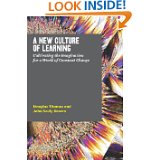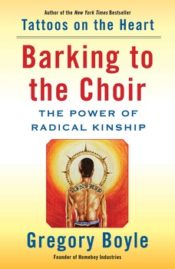“A New Culture Of Learning”: Dewey Redux
Posted on | April 24, 2011 | Comments Off on “A New Culture Of Learning”: Dewey Redux
 Two of the gurus of the Internet age have written a charming, compelling, and ultimately romantic book about what learning could be.
Two of the gurus of the Internet age have written a charming, compelling, and ultimately romantic book about what learning could be.
In the opening pages of A New Culture of Learning: Cultivating the Imagination for a World of Constant Change, Douglas Thomas and John Seely Brown lay out the dimensions of “arc of life” learning “which comprises the activities in our daily lives that keeps learning, growing, and exploring” (p. 18). (The book is self-published and available exclusively at Amazon.com.)
A New Culture of Learning starts out with a story about Sam. Sam is 9. He started playing with a computer program called Scratch, created at MIT to help kids understand the basics of design. Sam learned a lot. Within a few minutes he could create basic animations, but then Sam found out he was not alone in his efforts. A community of other kids was on line, and when Sam posted his game others could experiment with it, comment, build on it, and collaborate. Sam had entered the new culture of learning: play, collaboration, questioning, and imagination.
New learning may be child’s play, but it is vexing to adults, and it brought to my mind a much older volume featuring playful children connecting learning to the community, John Dewey’s School and Society, published in 1900. Dewey, too, wanted schools to individualize learning experiences, connect schooling to learning about the means of production, and wanted kids to explore and discover.
I am attracted to the world that Thomas and Seely Brown describe, a world in which a “bounded and structured environment that allows for unlimited agency to build and experiment within things within those boundaries” (p. 19): in other words, a space with rules and lots of freedom within that space. As the authors later reveal, their concrete version of the new culture of learning looks a great deal more like a massive, multiuser computer game than it does a conventional classroom. Much of what they advocate in A New Culture of Learning, is consistent with my thoughts in Learning 2.0.
But the story of education in the 20th Century is in large part a tale of how Dewey lost. Despite his damning commentary on waste in education, Dewey’s pedagogical ideas fell victim to the organizational mandates of industrial efficiency. Where Dewey had sought individualization, industrial efficiency produced a batch processing system. Where Dewey had sought matching school to student, industrial efficiency created tracking and social separation.
No less than Dewey did, the advocates of new learning face an existing institution that needs substantial positive incentives to change. Technology may change our children’s heads, but it is the legislatures and interest groups that will change the rules of the game.
(For a longer essay review of the A New Culture of Learning and Dewey’s School and Society, click here.)
Tags: "A New Culture of Learning" > California > Doug Thomas > Education Reform > John Dewey > John Seely Brown > Mimi Ito




